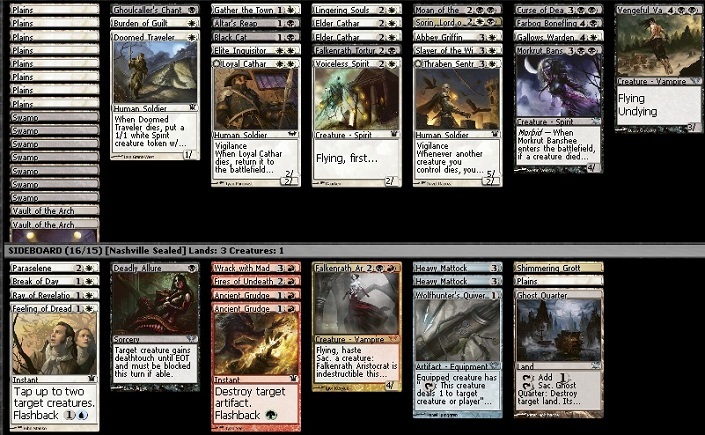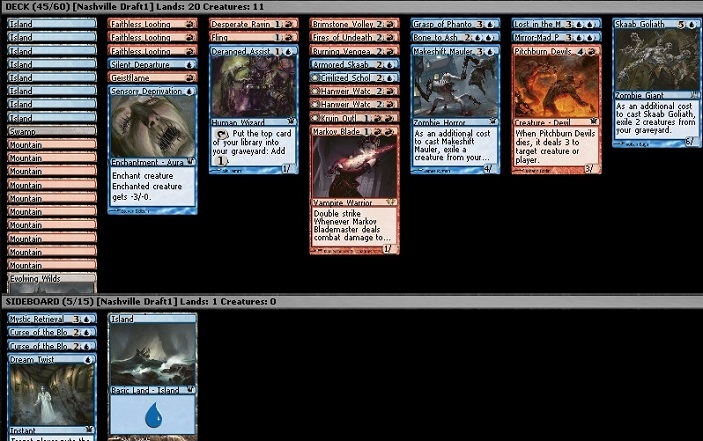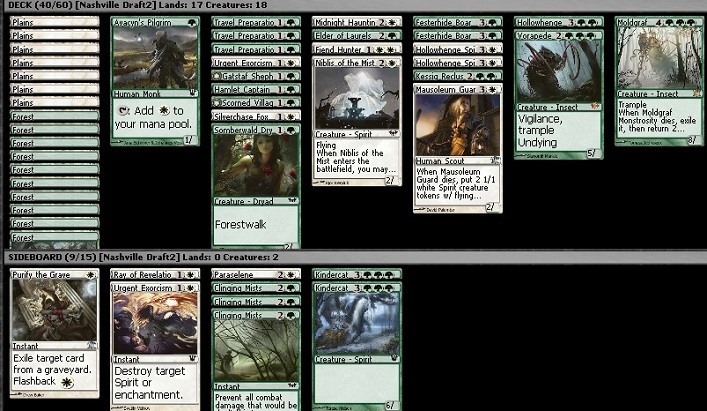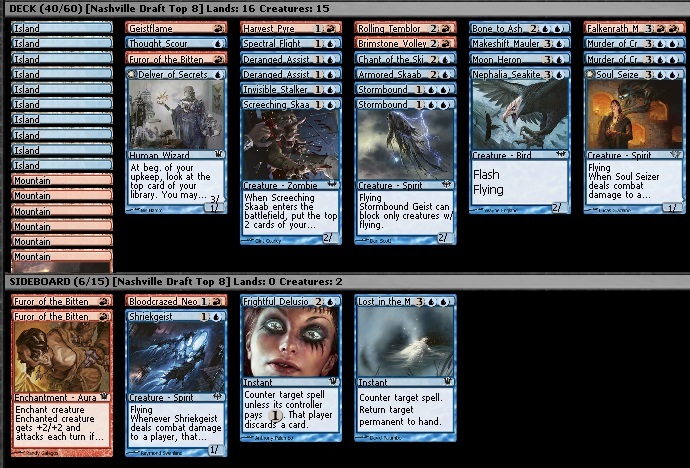It was late Friday evening, and we were halfway through the long walk back to the hotel when Gerard stopped short. “Actually,” he turned to us, “maybe we should go back and get the sleep-in special after all.” “Sure,” I said, “it doesn’t matter to me.”
The “sleep-in special” is an option for sale to Grand Prix players with byes. If you buy the sleep-in special, you can show up late and receive a pre-registered pool instead of coming early to do deck registration and exchange. Personally, I’m pretty indifferent between sleeping in and coming early. I dislike getting up at 7 AM as much as the next guy does, but the reason I’d first opted to sign up for Nashville in the regular way is that I honestly enjoy the deck registration process. The tension builds as you get to look at multiple card pools and hear everyone at the table bragging about opening this bomb or that one; the process generally adds to the excitement.
Receiving a preregistered pool, on the other hand, can be blunt, cruel, and final. The first cards you look at are the ones you’re stuck with all tournament; there’s no escape. Sitting there with the sealed box in front of you waiting for the judge to give you the go-ahead is torture.
So there I found myself on Saturday morning, regretting my decision as the judge took his sweet time to start the deckbuilding clock. When I finally opened the color-sorted card pool, my eyes went immediately to Dark Ascension lands and gold, to the cards I’d be “stuck with” all tournament.
To use the Sickbrew Sealed widget, click (don’t drag) individual cards from the pool into either the Junk, Pool, or Deck sections. You can click multiple cards at a time to move them all at once! Sort by cost, rarity, and color.
- 1 Shimmering Grotto
- 1 Ghost Quarter
- 1 Thraben Sentry
- 1 Abbey Griffin
- 1 Gallows Warden
- 1 Slayer of the Wicked
- 1 Elite Inquisitor
- 1 Voiceless Spirit
- 2 Elder Cathar
- 1 Doomed Traveller
- 1 Feeling of Dread
- 1 Paraselene
- 2 Thraben Purebloods
- 1 Curiosity
- 1 Hysterical Blindness
- 1 Laborator Maniac
- 1 Makeshift Mauer
- 1 Sensory Deprivation
- 1 Lost in the Mist
- 1 Forbidden Alchemy
- 1 Ghoulcaller’s Chant
- 1 Altar’s Reap
- 1 Moan of the Unhallowed
- 1 Curse of Death’s Hold
- 1 Morkrut Banshee
- 1 Stromkirk Patrol
- 1 Ghoulraiser
- 2 Ancient Grudge
- 1 Reckless Waif
- 1 Riot Devils
- 1 Burning Vengeance
- 1 Furor of the Bitten
- 1 Gutter Grime
- 1 Grave Bramble
- 1 Caravan Vigil
- 1 Lumberknot
- 1 Ulvenwald Mystics
- 1 Orchard Spirit
- 1 Avacyn’s Pilgrim
- 2 Vault of the Archangel
- 1 Sorin, Lord of Innistrad
- 1 Falkenrath Artistocrat
- 1 Immerwolf
- 1 Altar of the Lost
- 2 Heavy Mattock
- 1 Wolfhunter’s Quiver
- 1 Burden of Guilt
- 1 Gather the Townsfolk
- 1 Break of Day
- 1 Ray of Revelation
- 1 Loyal Cathar
- 1 Lingering Souls
- 1 Artful Dodge
- 1 Shriekgeist
- 1 Nephalia Seakite
- 1 Chant of the Skifsang
- 1 Divination
- 1 Screeching Skaab
- 1 Stormbound Geist
- 1 Black Cat
- 1 Deadly Allure
- 1 Farbog Boneflinger
- 1 Vengeful Vampire
- 1 Falkenrath Torturer
- 1 Hinterland Hermit
- 1 Shattered Perception
- 2 Russet Wolves
- 1 Wrack with Madness
- 1 Fires of Undeath
- 1 Dawntreader Elk
- 1 Scorned Villager
- 1 Somberwald Dryad
- 2 Young Wolf
- 1 Ghoultree
- 1 Tracker’s Instincts
- 1 Hunger of the Howlpack
- 1 Hollowhenge Beast
I’m not typically the one to brag and boast during deckbuilding, but I couldn’t contain myself this time. This wasn’t the sort of deck you get in real life. This was the sort of deck you hear rumors of some nameless, faceless player opening, but it was the sort of deck you never even see with your own eyes, let alone get to play with.
I tried to stay calm. Just to be thorough, I laid out some other color combinations: black/blue, red/green, red/black. They looked good at first, but then I just started laughing out loud. Honestly, how good does a Young Wolf/Geistflame deck have to be to get the nod over this?

You might think that I was feeling great, but in fact I was stressed out and nervous. Everyone was expecting a lot; I was expecting a lot; what if I blew it? Two weeks before at Grand Prix Seattle, I’d opened an excellent pool and failed to make Day 2. Everyone was acting as though I’d been handed day 1 of the tournament on a silver platter, so it would’ve been embarrassing and disappointing to not make the most of the opportunity.
The fact is that there’s more to having a good day in Limited MTG than just getting a good deck. In Seattle, the games and matchups didn’t go my way but this weekend, they did. Being confident in my deck allowed me to be a little more liberal with my mulligans than I might have otherwise been, but I was careful to always take my time and never to feel like I was entitled to win the game. I went undefeated with the deck and finished the day 9-0.
In retrospect, I made one mistake during deckbuilding.
My brother and I have a running joke: whenever we get paired in a tournament, he tells me he’s sideboarding in extra lands because the only way he can lose to me is mana screw. As I played the first few rounds, I began to realize that there was a lesson in our stupid joke; my deck was simply so much more powerful than most of my opponents that so long as I was playing my best, the most realistic way to lose was mana screw. Even though my deck had a low enough curve to function just fine on seventeen or even sixteen lands, I should’ve maindecked eighteen. Flooding is never ideal, but as long as I had at least something, I could sink my mana into Vault of the Archangel and stay in the game.
I often sideboarded an extra land, and sometimes turned to Break of Day or Ray of Revelation to replace the two weakest cards in the deck: Abbey Griffin and Ghoulcaller’s Chant. In one round, I even added red to the deck for the main purpose of having Ancient Grudge to answer my opponent’s Helvault (and the secondary purpose of playing Falkenrath Aristocrat and extra removal).
A not-so-surprising MVP was Elite Inquisitor. His first strike and vigilance worked perfectly with Vault of the Archangel, and his protection from Vampires allowed me to beat a Bloodline Keeper through brute force when I suited him up with two Elder Cathar counters. A more surprising one was Falkenrath Torturer. Between Gather the Townsfolk and two Elder Cathars, the unassuming 2/1 made combat difficult for my opponents and gave me extra flexibility in racing and in protecting Sorin. In general, though, it was my bombs that did the heavy lifting.
So I did not embarrass myself in Day 1, but I still felt pressure and that I had something to prove. Going 3-3 or 2-4 in Draft at a high level of competition is something that can happen to any player on the planet on a given day. However, I knew that if I missed the Top 8, the cynical pessimists out there (not the least of which is myself) could claim that I’d just been lucky to open a great sealed deck and didn’t really have the skills to pay the bills.

This draft may have been the most interesting part of my tournament. Round 11, I was going to game 3 on the draw against a very aggressive W/G deck and only ten minutes remained on the clock. I knew I had to make a big move, so I cut my two counterspells, cut my Skaab Goliath, and cut two lands. I did not replace them.
The deck I registered in the first draft had 45 cards. I wrote down forty-seven on my decklist, but I crossed two out at last second because I wanted to show some discipline…
In all seriousness, the decision to play 45 was well thought-out. It was not made out of laziness or uncertainty; I feel that it was the best way I could’ve built the deck. For one thing, between three Faithless Lootings, Desperate Ravings, Civilized Scholar, Armored Skaab, and Mirror-Mad Phantasm, decking myself was a real concern. In fact, in the game where I sided down to 40, I very nearly lost due to a decking after a Mirror-Mad activation.
More important than the risk of literally having zero cards in my library, though, was the risk of running too thin on win conditions. Having a deeper deck allowed me more flexibility in what I discarded with Faithless Looting. Imagine I was to draw my Skaab Goliath in the opening seven: clearly, this is not a card I wanted clogging up my hand all game, but if I was too thin on win conditions I would’ve had to be cautious in ditching it for fear of being unable to win in the long game. With forty-five cards, I could be more liberal and not worry quite so much about the ultra-long run.
Finally, the amount of searching I had meant that I would see a large portion of my deck every game, and each additional card meant more options and more room to play. Cards like Skaab Goliath, Lost in the Mist, and Fling were not in my deck because I wanted to draw them as often as possible; they were in my deck because I wanted access to them as the game went very long.
If I had forced myself to go to 40, I would’ve cut Fling, Bone to Ash, and Lost in the Mist (along with two lands). Those cards ended up being among my best performers as they gave me the option—they didn’t force me into anything because I typically had the option to cycle them—they gave me the option to pass the turn, flip my Werewolves, and still be able to defend myself.
I would never go into a draft planning to play more than 40 cards, but it’s important to keep an open mind in MTG. Just because everybody does things a certain way doesn’t necessarily mean that’s the only way to do things.
In the end, buying that extra pack of sleeves was well worth it, and I went 3-0 with my slightly heavy U/R deck.
Going into the second draft of the day, I was all but guaranteed to make the Top 8, but I’m much too proud to let people walk all over me. My plan was to draft the best deck I could, offer a draw to each of my opponents, and show no mercy to anybody who decided to take their chances.

I was pleased with this deck, though I feel it was my weakest of the day. I won a very close round 1, and then drew the next two rounds. W/G Beatdown is a brutal and powerful archetype in Innistrad draft, but it was a far cry my previous triple-Faithless Looting deck. The W/G had no card selection and nothing to ensure consistency. I could get amazing draws, but I could also mulligan, get mana screwed, or get flooded.
During the draft, I aimed to reduce the inconsistency factor as much as I could, prioritizing cheap creatures above all else. Late in the draft, I grudgingly took a Hamlet Captain over Essence of the Wild because I felt I desperately needed two-drops.
The toughest pick of the draft came midway through pack 2. I already had one Travel Preparations and faced the option to take a second, an Avacyn’s Pilgrim, or a Prey Upon. Though all three are premium cards for a W/G deck, I eventually settled on the Travel Preparations as the highest-impact card. My mistake, though, was that I should’ve suspected that a third Preparations could be wheeling to me based on what I thought my opponents were drafting, and similarly that I had the potential to get all of the Travel Preparations opened in pack 3. I’d take two Travel Preps before my first Pilgrim or Prey Upon, but once you get into the realm of three or four copies there are diminishing returns. In retrospect, I wish I’d planned ahead better and taken the Pilgrim. Luckily, I ended up opening one in pack 3, and I didn’t see any more Travel Preparations beyond the one that wheeled in pack 2.
Drawing the final two rounds allowed me some time to eat, relax, and psych myself up for the Top 8. Before this weekend I had no flight to Pro Tour Avacyn Restored, so a Top 4 would have been great. More importantly, I had no Grand Prix trophy, so a first place would’ve been even better! However, the Top 8 was stacked with talent, and I had my work cut out for me.

Luck was on my side during the draft. I didn’t open a bomb rare or uncommon, but that ended up being a blessing because it provided me with an excuse to take the draft in the direction I wanted it to go. For lack of a standout card I turned to blue, which is both the most powerful color and my personal favorite. I first and second picked Stormbound Geists, and blue turned out to be wide open. I wasn’t even forced to choose a support color until Innistrad rolled around.
With an Invisible Stalker to go with the two Stormbound Geists, I felt I could take my deck in an aggressive direction and utilize Spectral Flight and Furor of the Bittern without leaving myself too vulnerable to two-for-ones. Nearly every creature in my deck was flying, which not only made opposing ground blockers look silly, but also allowed me to maindeck Rolling Temblor, which saved my skin in the semifinals against Kyle Babin’s R/B Vampires deck.
In the end, I didn’t feel that it was the Furor of the Bitten gimmick that defined my deck but simply the card quality of two Murder of Crows and red burn to back them up. Like much of the tournament, my draws were good and I got lucky when I needed to. In the finals, both games I curved out with Deranged Assistant straight into four- and five-drops.
In the end, I couldn’t feel happier about the tournament. On the one hand it felt like a long-awaited weekend of incredible luck after a frustrating dry spell. Everything lined up perfectly to give me the opportunity to win the tournament. On the other hand, I’m proud of myself as there were plenty of places where I could’ve blown it and didn’t!
I owe the GP Nashville win to a combination of hard work and good fortune. The help and advice of other people also played no small role. Throughout the weekend, I had the voices of my family, friends, and teammates ringing in my ears, helping me to stay confident and focused, to remember that there were other people rooting for me, and, of course, helping me to make the right decisions within the games.
Thanks to everyone who helped me prepare for the tournament, who watched me while I played, and who congratulated me on the win! Thanks, as always, to my readers as well for letting me share my story. I hope you’ve enjoyed it.
